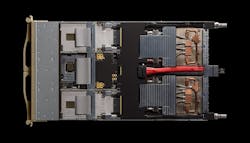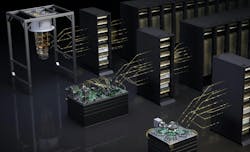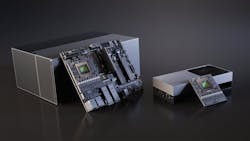What's New at GTC DC 2025?
What You'll Learn
- What's new with quantum computing.
- How the Vera Rubin CPX Compute Tray will affect the Open Compute Project community.
- What's up with NVIDIA and Physical AI?
NVIDIA's GTC (GPU Technology Conference) Washington, D.C. 2025 event just wrapped up. As usual, the keynote was by CEO Jensen Huang (watch the video above).
Liquid Cooling and OCP Platforms
Of course, AI and the cloud were front and center. Jensen talked about a number of topics, including NVIDIA's Vera Rubin CPX platform with its liquid-cooling support (Fig. 1). NVIDIA is not the only company that's heavy into liquid cooling. Partners like ASRock announced liquid-cooled systems based on NVIDIA chips at the Open Compute Project's OCP Global Summit earlier this year.
Linking to Quantum Computing
NVIDIA NVQLink was also on the docket. This is an extension of the NVLink switching support used with its GPUs. NVQLink is designed to connect quantum processing uniits (QPUs) with conventional supercomputers so that developers can take advantage of NVIDIA CUDA-Q, an extension of the company's popular CUDA software environment (Fig. 2).
CUDA-Q is an agnostic QPU software platform. There are a number of different QPU architectures and technologies with differences that can be masked by CUDA-Q, enabling developers to create applications that will work with any platform.
NVQLink provides low-latency, high-throughput connections needed to handle control tasks like quantum error correction.
NVIDIA's Plans for Physical AI
The push from chatbots to agentic AI to "physical AI" was highlighted in the keynote. Physical AI seems to refer to humanoid robots that can operate independently and in human environments interacting with people. It's a bit forward-looking, although cobots already exist yet they require custom programming. At this point, humanoid robots are still in the research stage, but NVIDIA's new chip is designed to facilitate this development.
The IGX Thor robotics processor is NVIDIA's latest edge solution (Fig. 3). It's an industrial-grade, edge AI platform based on the company's Blackwell GPU with 2,560 GPU cores, 96 Tensor cores, and 10 texture processing clusters (TPCs). IGX Thor also features a 14-core, 64-bit Arm Neoverse-V3AE compute complex.
About the Author
William G. Wong
Senior Content Director - Electronic Design and Microwaves & RF
I am Editor of Electronic Design focusing on embedded, software, and systems. As Senior Content Director, I also manage Microwaves & RF and I work with a great team of editors to provide engineers, programmers, developers and technical managers with interesting and useful articles and videos on a regular basis. Check out our free newsletters to see the latest content.
You can send press releases for new products for possible coverage on the website. I am also interested in receiving contributed articles for publishing on our website. Use our template and send to me along with a signed release form.
Check out my blog, AltEmbedded on Electronic Design, as well as his latest articles on this site that are listed below.
You can visit my social media via these links:
- AltEmbedded on Electronic Design
- Bill Wong on Facebook
- @AltEmbedded on Twitter
- Bill Wong on LinkedIn
I earned a Bachelor of Electrical Engineering at the Georgia Institute of Technology and a Masters in Computer Science from Rutgers University. I still do a bit of programming using everything from C and C++ to Rust and Ada/SPARK. I do a bit of PHP programming for Drupal websites. I have posted a few Drupal modules.
I still get a hand on software and electronic hardware. Some of this can be found on our Kit Close-Up video series. You can also see me on many of our TechXchange Talk videos. I am interested in a range of projects from robotics to artificial intelligence.



